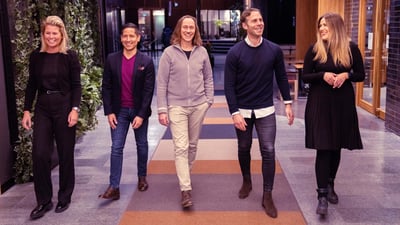How to Attract the Right Competence with New Technology
On June 23rd, Sara Dalsfelt, Adway’s Senior Advisor of Digital TA, was joined by two of TietoEVRY’s top TA professionals: Anna Gulliksen, Global head of Talent Acquisition & Employer Brand, and Isabella Seege, Employer Brand Country Lead in Sweden. In their high-energy, hyper-insightful session, they dove deep into the many ways an organisation’s global D&I OKR’s can be successfully practiced in reality.
ADWAY TALKS is an educational webinar series for anyone who’d like to live in the limelight of Talent Acquisition. With a combination of applied expertise and an intense love for data, it’s time to walk the D&I talk - because the future of TA depends on it!
Want to study up on all the key findings? Watch the recording below and/or keep reading!
Background Check
TietoEVRY is a leading digital services and software company that’s constantly looking for the most hard-to-attract candidates out there. They employ more than 24,000 experts globally and serve thousands of customers in more than 90 different countries. A guiding principle of theirs is to always try new technology and challenge the IT industry around unbiased recruitment and diversity in tech.
How to Make Better Data-Driven Decisions, And How Does it Affect TA?
A data-driven approach to TA can deliver the kinds of insights that are crucial to informing and improving business outcomes. They can illuminate whether or not a candidate is a cultural add to the organisation, how to optimise your processes and technologies, and the true impact TA is having on the business bottom line.
Data and analytics can also help your organisation make strategically informed hiring decisions and yield optimal results for the following metrics:
- Time-to-hire
- Cost-per-hire
- Candidate experience scores
- Job offer acceptance rates
Data and analytics can help recruiters and hiring managers through every step of the candidate experience, from:
- Sourcing and lead generation; to
- Attracting and connecting with dream candidates
- Engaging and interviewing candidates
- Assessing candidates’ skills
- Making final candidate selections
- Hiring and onboarding new employees
Basically: data-driven decisions strengthen and streamline the entire TA engine. Some key stats that underline this promise:
- Big data is considered the best hiring method by 50% of professionals.
- Data-driven hiring increases employee retention by 56%.
- Data-driven hiring is 50% better at determining the skills gap.
- Data-driven hiring has made experts 45% more capable of understanding a candidate’s needs.
- 69% of TA professionals believe that big data can greatly improve their job.
- Companies that use data to automate decision-making are twice as likely to improve quality of hire.
- Only 32% of senior leaders are confident in the data that they have available to make decisions.
- Only 27% of enterprise companies are planning to automate more than 50% of their talent acquisition processes.
- Arm your hiring managers with data! Sixty-seven percent of talent acquisition and HR professionals are not providing hiring managers with the right data to make decisions. Hiring managers don’t live in this world, so you can work backwards to build the appropriate hiring plan by bringing the right data to the table (turnover, performance, etc.). Show them we’re all in this together, be a strategic business partner, and get your budgets approved.
When tasked with the lofty goal of recruiting a large influx of young talents, TietoEVRY decided to turn to gamification! Since the supply of candidates was lower than their demand, they had to find creative ways to stand out from the crowd.
By turning the traditional recruitment process upside down, TietoEVRY used gamification testing to assess their candidate’s cognitive thinking, problem solving and personality traits. Based on the results, a video interviewing process ensued, followed by a meeting with their potential manager. By the time they got to the last step in the candidate journey, these talents filled every last criteria based on usable data.
TietoEVRY also tapped into the powers of TA technology, with a gamified psychometric assessment tool that weighed relevant skills, personality traits and motivation and removed unconscious biases about gender, age, etc. from the equation. It was another way they were able to use objective TA technologies and tools to increase objectivity and fairness and make sounder hiring decisions.
How to Use Diverse & Inclusive Content to Attract the Right Candidates
It all starts with diverse and inclusive content in the recruitment marketing itself! From gender-neutral and inclusive language, to inviting advertising images, to the promotion of a diverse and inclusive team culture and employer brand — attracting talented women to join your workforce means ensuring there are no barriers or biases right off the bat.
When it comes to attracting diverse candidates and promoting a favorable employer brand, TietoEVRY’s data-driven strategies have seen successful results:
- Through A/B image testing, they’ve experimented with their job ads to see an increase in the number of female applicants.
- With small changes to tone-of-voice, they’ve seen an increase in female applicants.
- By changing gendered content (i.e. switching out the word “independent” with “self-directed” and changing “competent” to “knowledgeable”), they’ve seen a 32% increase in female applicants!
Why You Can’t Let Fear Paralyze You From Making D&I Promises a Reality
The first step to closing the capability gap, increasing analytics maturity and bringing D&I promises to life is to STOP being scared or intimidated and start understanding how TA analytics affect the candidate journey, your interactions with key stakeholders, and what both they and the organization can gain from it.
Consider the D&I outcomes your organisation is driving toward, and the types of insights that will support achieving those outcomes and keeping your promise as a business.
Some key stats thatunderline this promise:
- Nearly 90% of companies are concerned with reducing bias in their talent acquisition process, so the need is clearly there.
- Unfortunately, almost half of managers have higher priorities than creating a diverse and inclusive workplace.
- If the global workforce became equally gender-diverse, the global GDP could increase by $28 trillion!!
- 86% of women and 74% of men also seek employers with diversity and inclusion strategies in place
- 57% of employees say they believe their companies should improve diversity among the internal workforce.
- 13% of employees monitor how often senior managers discuss D&I during meetings.
- Nearly 50% of employees said their companies could improve diversity of gender, race and ethnicity.
- Just 3.2% of Fortune 500 companies openly share race and gender demographics of their employees. Don’t you want to stand out above the rest?
How to Practice Conscious Inclusion in Your Organisation
Diversity & Inclusion is more than just a statement on the company website. In order for it to truly be prioritised, it must be tied to clear goals and KPIs. In fact, at TietoEVRY, they are tracking to achieve a 50/50 gender balance (from 29% currently) by 2030.
A few ways they are actively making good on their D&I promises include:
- Becoming EDGE certified, the leading global assessment methodology and business certification standard for gender equality.
- Being in position #3 on the SHE Index in Sweden.
- Creating gender-focused succession plans and gender balance across their leadership roles.
- Being proud partners to Pride in all Nordic Countries and Friends in Sweden.
- The Polite Type is an open-source font that rewrites hurtful words, replacing them with more inclusive ones. The Polite Type is meant to be used for educational purposes, at schools or by parents - one way to approach this issue and to create a safe space for discussion.
- Bias training for all managers to increase awareness.
- Creating and sustaining strategic partnerships that attract women to the tech industry, help them get hired, and take their careers to the next level.
How to Challenge Your Business by Connecting D&I to the Bottom Line & Your Promise as a Company
Building a diverse team doesn’t just alter the morale of your company, it affects the financial success of the business itself.
Some key stats thatunderline this promise:
Talking about your grand plans for D&I is easy. It’s another story to walk the walk. Here’s how you can make your D&I promises a reality, with a little bit of advice from TietoEVERY:
- Acknowledge that this is more than just an HR issue. Start with awareness of the bias itself. You’d be surprised by how many organisations haven’t even gotten this far!
- Educate the workplace and lead by example.
- Make the cultural shift FROM diversity TO inclusion.
- Create leadership positions that focus on D&I.
- Understand that competence is not related to a specific sex, age, ethnical background, religion or other factors that limit candidates.
- Use unbiased forms of smart recruitment technology like automated recruitment marketing software, gamification, social media job advertising, automated candidate assessment tools, AI-powered chatbots and conscious inclusion decision platforms.
The Top Two TA Takeaways
From Anna:
- Look at the whole process - from awareness all the way to signing the candidate. Dive deep into every single step, then identify the pain points.
- Keep it simple - don’t overcomplicate.
From Bella:
- If we wait and strive for perfection, we can easily become paralyzed. So, dare to test and try new things -it’s the only way to make a change.
- Start somewhere - test, evaluate, and try again. Don’t try to cover it all at once.
Questions From the Audience
As women tend to underestimate themselves, it’s important to avoid long lists of demands - keep it brief and to no longer scare off female candidates! What is your best advice to succeed to attract female candidates?
What women want:
- To be engaged on social media (because 71% of social media users are women)
- To see proof of female-focused benefits (like flexible work and parental leave policies)
- To view clear context into their role (through transparency about your team, work environment, company culture, and values)
What women don’t want:
- Long lists of demands in your job descriptions (because they’ll only apply if they feel 100% confident in their ability to crush it!)
- Dominating or non-inclusive job ad language (44% of women would not apply to a role if the job description included the word “aggressive”)
- A lack of transparency about salary (because it signals a red flag for a gender pay gap…)
Being transparent about salaries is another way to engage with women. It’s ranked as an important part of a job description and helps demonstrate the work your company is doing to eliminate the gender pay gap.
How can smart campaigns in Social Media help you with unbiased recruitment?
There are 4.2 billion people on social media, and these sites are made up of users from every country, race, gender, sexual orientation, and skillset under the sun! Since social media eliminates biased targeting, it can help you reach more diverse candidates . It also showcases your one-of-a-kind employer brand and culture, so candidates can see EXACTLY what working with your organization is like!








